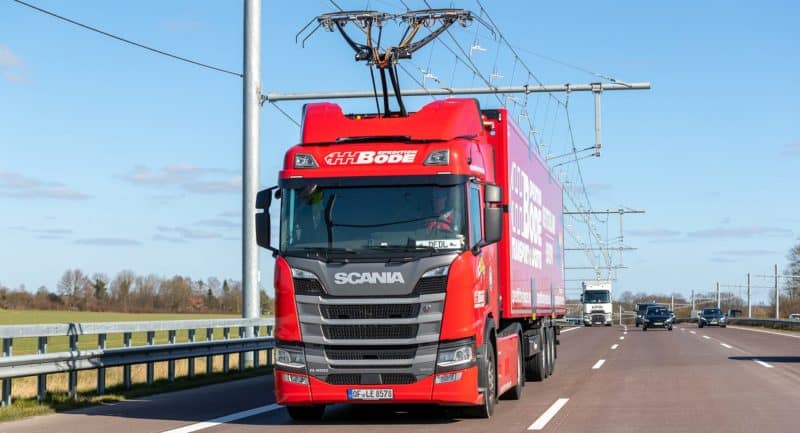After what has already been a busy year for the UK’s haulage sector, we bring you an update about a potential future for the industry. It relates to a government-funded study into the cheapest way in which to decarbonise HGVs – one that has found that powering HGV vehicles via overhead charging cables represents by far the most viable option.
This highlights a possible strategy to be implemented in order to meet the objective of decarbonising all HGVs by 2050. Battery electric trucks are being seen as the most likely solution for reducing current levels of carbon emissions, with the ‘greenest’ method of recharging them being the current point of contention.
By Far the Cheapest Option
The study’s findings show that when compared to other options, powering HGV batteries with overhead cables is clearly the most cost-effective route to take. According to Professor David Cebon from the Centre for Sustainable Road Freight (CSRF), ‘topping up’ much smaller batteries via overhead catenary cables was the most “technologically ready”.
Speaking after the feasibility study carried out by a consortium that included SPL Powerlines, Siemens Mobility and truck manufacturer Scania, Professor Debon spoke about the surprising efficacy of the method, stating that there were similar systems running in the United States, Sweden and Germany…
“It’s not just a fantasy in the UK, there’s quite a lot of interest in Europe and India and China. What it means is much, much smaller batteries. You could have a 150kw/h battery in almost every truck in the UK. In general, it reduces battery sizes by at least a factor of two, if not more than that. These are much more efficient even than straight battery electric vehicles.”
Within the Government’s Existing Budget
Prof Debon also went on to talk about the fact that while the proposed cost of the scheme in the UK of around £20bn might sound high, the government’s current budget for the roads for 2020-2025 is significantly higher, at £28bn. Continuing to pay hydrogen subsidies, he said, would work out much more costly.
UK Transport Secretary Grant Shapps also contributed to the overhead cabling conversation last week when questioned by MPs on the transport select committee about how the haulage sector plans to decarbonise. He said:
He said: “We have already had an extensive discussion about bigger vehicles, buses and lorries.
There’s been massive investment into one experiment using overhead wires for trucks. I am not sure we want to do that to all our motorways, but it’s an interesting in principle investigation.”
Following the success of the Zero Emission Road Freight Trials programme, we are now working to expand the programme to trial multiple zero emission HGV technologies on UK roads.
As we drive towards our net zero targets, we’re committed to making our air cleaner and the way we transport goods kinder to the environment. We will announce further information regarding future trials in due course.”
An Interesting Look Into The Future of HGV Driving
Whatever the eventual outcome of this process, there’s no doubt that there are some interesting times ahead for the UK’s haulage sector. Britain’s roads will likely look very different when electric trucks are being driven on them, particularly as 5,000-7,000 miles of overhead cabling will need to be installed.
Going forwards, the HGVC team will continue to support the sector by providing industry-leading HGV licence acquisition programs that ensure the ongoing driver shortage is overcome. To find out more about how we work, please take a few minutes to browse around our website, which contains everything you need to know.
Alternatively, to get in touch with us directly, either click ‘contact us’ or call us on 0330 818 8888, and we’ll be more than happy to discuss your requirements.

